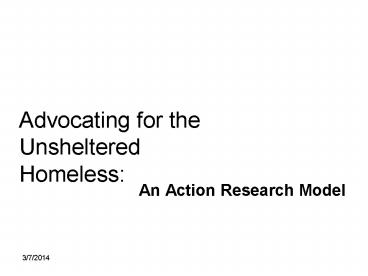Advocating for the Unsheltered Homeless: - PowerPoint PPT Presentation
1 / 15
Title:
Advocating for the Unsheltered Homeless:
Description:
... county, rural-urban community. 9/26/09. Reciprocal Benefits. Continuum of Care ... Reciprocal Benefits. Community-at-large. HUD grant funding (over $1 million) ... – PowerPoint PPT presentation
Number of Views:38
Avg rating:3.0/5.0
Title: Advocating for the Unsheltered Homeless:
1
Advocating for the Unsheltered Homeless
- An Action Research Model
2
A Presentation by
- The Homeless Count Taskforce
- a subcommittee of the
- Springfield MSA Continuum of Care
- sponsored by
3
Presented by
- Alissa C. Jecklin, MSW
- Missouri State University
- Mary Anne Jennings, PhD
- Missouri State University
- Christopher P. Smith, MSW
- Community Partnership of the Ozarks
- and
- Danell McCoy Vaughan, MSW
- Community Partnership of the Ozarks
4
Project Overview
- Service learning partnership
- Missouri State University School of Social Work
- Community Partnership of the Ozarks
- Continuum of Care (CoC)
- Assessment of needs of homeless persons in a
tri-county, rural-urban community
5
Reciprocal Benefits
- Continuum of Care
- Methodologically sound assessment of the homeless
population - Greater legitimacy of data
- University/Faculty
- Exploration of research questionsspirituality
- Greater engagement with community
- Fulfillment of public affairs mission
- Students
- Professional development
- Applied research experience
- Skills in professional collaboration
6
Reciprocal Benefits
- Community-at-large
- HUD grant funding (over 1 million)
- Targeting resources to critical needs
- Engagement/advocacy opportunities
- Homeless Community
- Opportunity to have voices heard
- Targeted resources should meet needs more
effectively
7
Methodology of 2007 Count
- Street Count of Unsheltered Homeless
- Built rapport
- Sample
- Data collection
- Approach
- Training
8
Methodology of 2007 Count
- In-depth Interview Instrument
- Informed consent
- Incentives
- Training
- Examples of categories of items
- Disabilities
- Demographics
- Experiences with homelessness (e.g., frequency,
injury, length) - Veteran status
- Use of services
- Perceived needs
9
Initial Project Findings
- Street Count 266 unsheltered homeless
- 500 increase
- Solid baseline data
- Initial database completed
- In-Depth Interviews 114 completed
- Comprehensive report with detailed information on
26 variables - Useful tool for grant writers, advocates, and
researchers
10
Sample of Initial Project Findings
- Mean age 41.32 years (range 20 to 65)
- Mean education 11.63 years
- 37 no permanent place 2 or more years
- 66 in Springfield more than 2 years
- 52 family contact 0 to 7 days
- 80 some kind of disabling condition
- 95 belief in higher power
- 25 in foster care
- 18 veterans
11
Student Activities
- Fundraising
- Street counting
- Interviewing
- Training
- Instrument Design
- Volunteer Recruitment
- Data Analysis
- Presentation of Results
12
Community Engagement
- Donations
- Reports in the media
- Homelessness Policies
- Community Volunteers
- Simulation Exercise
- Survival Game
13
What Learned from Counts
- Best locations
- Training
- Expansion of count
- In Springfield
- In rural areas
- Capacity building activities
- Expansion to other disciplines and other
universities (nutrition) - Community volunteers to count (e.g., churches)
- Modification of interview instrument
14
Long-Range Plan
- Funding
- Grants
- Business community
- Additional CASL opportunities
- Interdisciplinary Cooperation
- Methodology
15
- Questions?































